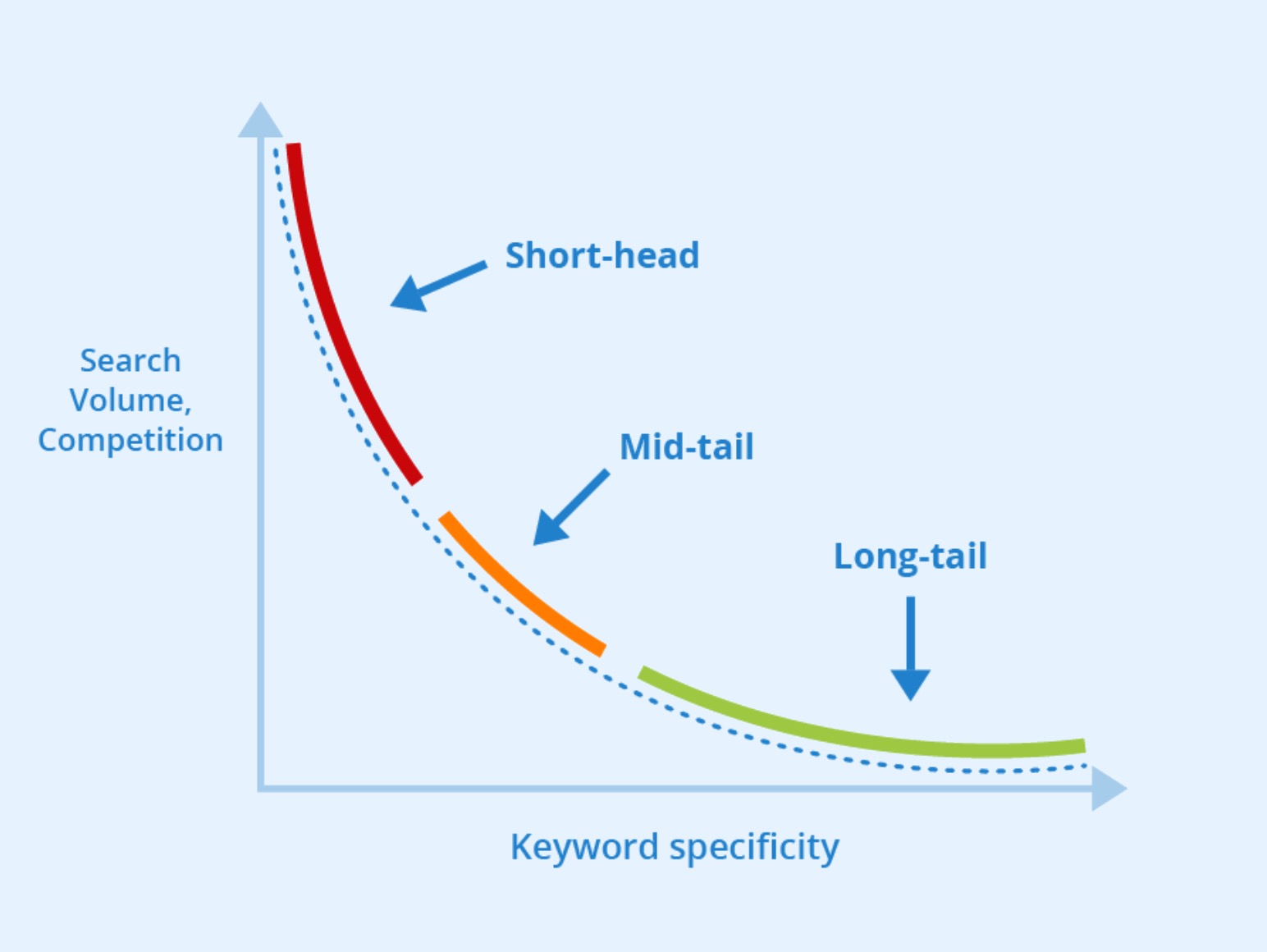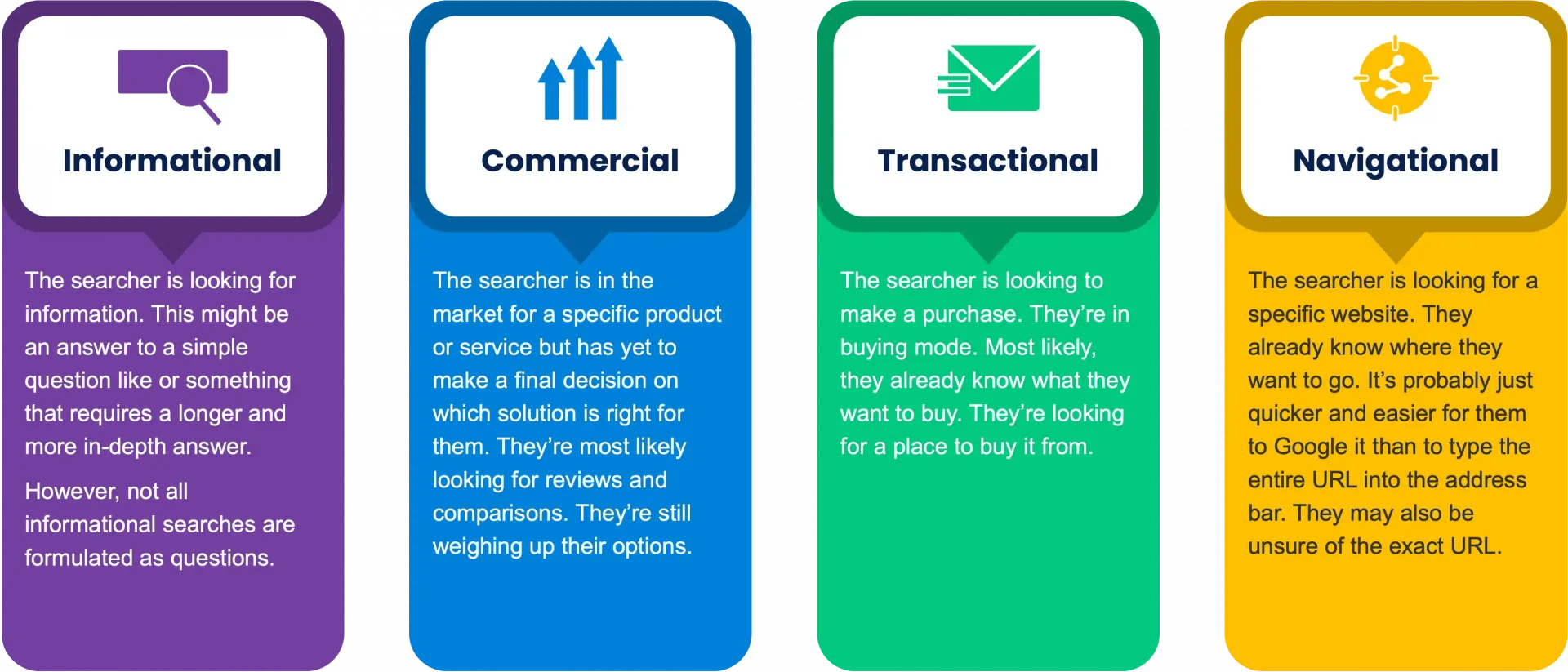Search Engine Optimization
#6 Keyword research
Keyword research
Understanding keywords makes you understand your audience!
Keyword research is a powerful tool that can aid in comprehending your target market’s search behavior and preferences for your content, products, or services.
Through keyword research, you can gather specific search data that can answer essential questions such as what people are searching for, how many people are searching for it, and in what format they prefer the information.
This data can open up a new world of strategic SEO as you gain insights into how your audience searches for your content. Therefore, keyword research should be the first step in your SEO journey, especially in two crucial scenarios:
A) Firstly, it helps you familiarize yourself with your niche by providing an overview of the sub-topics that interest your target audience.
B) Secondly, it aids in finding profitable keyword opportunities and planning your content strategy for generating new content ideas.

When conducting keyword research, it is crucial to survey the SERP landscape for the keyword you wish to target. This step helps in gaining a better understanding of the searcher’s intent. By examining the search engine results page (SERP), you can identify the type of content that your target audience is searching for.
Remembering this aspect of the keyword research process is essential to avoid optimizing for the wrong keywords. Therefore, examining the SERP landscape can provide insights into the type of content that resonates with your target audience, allowing you to optimize your content accordingly.
Before keyword research, know your audience!
Before working on SEO, you must understand who your customers are, their needs, pain points, and goals. Mapping who your customers are from a marketing point of view, you will inevitably come across the term persona.
What is a persona?
A persona is fundamentally a conceptual model of a perfect customer, formulated through in-depth user research to mirror a company’s targeted populace’s conduct, wishes, and aspirations. Developing a user or buyer persona requires integrating qualitative and quantitative data from genuine product users.
The importance of personas
Personas play a crucial role in creating effective marketing strategies. They assist businesses in understanding the choices of their specialized market segments by evaluating feedback and consumer activity. This comprehension aids in integrating these findings into the strategy for upcoming marketing initiatives.
Not knowing the defining traits of their intended customers can make it difficult for companies to engage and persuade potential clients. An in-depth understanding of buyer personas sheds light on various consumer demographic and lifestyle trends.
In contrast, recognizing the particular difficulties of customers may result in failure rather than triumph for a business.

Different kind of personas
The following section outlines the various kinds of personas that can be established.
User personas
This is a detailed profile originated from market research and practical involvement that clarifies the vital characteristics, requirements, and intentions of the users of the product. In the area of consumer items, this persona combines the features of both the consumer and the buyer.
Buyer persona
Especially for B2B, the buyer persona is vital in navigating the purchasing decision process. This persona could cover several influential individuals in a corporation who exercise substantial influence over decision-making, regardless of whether they use the product. It’s vital to make a clear distinction between the necessities, challenges, and goals of the buyer persona as opposed to the user persona.
Decision-maker persona
In the B2B sector, the decision-maker persona indicates a group of authoritative individuals crucial to the purchasing process. This persona often represents the organizational leader, concerned with the extensive effects of decisions and their coherence with the company’s overarching vision and objectives.
Customer persona
The customer persona signifies the fundamental model representing a product’s primary target audience. It might appear as the user persona within a B2B situation or a combination of the buyer and user personas in a consumer-oriented product. Therefore, within a B2B structure, the customer persona could personify either the buyer or the user persona.
In general, how do I create a persona?
When setting out to shape a user or buyer persona for your business, the following section provides a selection of tested approaches to simplify the task.
Start with the user persona
Initiate the development of user personas before diving into planning your product strategy. These profiles should be established early, even before the product vision takes shape.
Base your persona on actual individuals
Evidently, the most credible personas are not born from simple guessing but from interactions with real people who embody your desired customer base and the market you aim to serve. If conducting interviews is impractical, resort to deploying surveys. The fundamental rule is that the more genuine feedback you collect, the more precise your personas will become.
Merge data with stories
Creating the finest user personas involves a balanced mix of statistical information and personal stories collected from interviews. They merge detailed insights from personal engagement and surveys with the empirical data obtained from market research.

Creating a persona
There is a sequence of steps you can take to create a persona. Typically there are several persona profiles you need to develop. You also have to consider that there are different sets of personas depending on the customer segments your company is serving.
For each customer segment, identify at least four different personas by following these steps:
- Outline their job title.
- Describe their professional role – what is it that they do daily?
- Identify the persona’s background, education, career, skills, etc.
- Demography, i.e., gender, age, socioeconomic class, etc.
- Character, personality, way of managing people, management style, etc.
- Online behavior, Internet experience, usage of devices, digital maturity, etc.
- List their goals & objectives / things they aim to achieve – these can be both professional and personal.
- List the barriers & challenges preventing their goals from being achieved – consider the challenges they face daily.
- List how they gauge success – what would they consider a KPI? Is it a financial target or a ‘soft’ value such as staff happiness?
- Given the analysis, formulate a quote for the persona – what might they say about your solution offering?
- Identify how your business can help.
How often are keyword searched for?
Uncovering search volume
Keyword difficulty is a term used to describe the amount of effort required to attain higher rankings, and it is often related to the search volume for a particular keyword or phrase of keywords.
Higher search volume typically translates to more competition and significant effort to achieve higher organic ranking success. However, targeting terms with lower search volume may be more beneficial as they are less competitive.
While it is essential to focus on keywords your audience is searching for, targeting low-volume keywords can be advantageous. However, there is a risk of not attracting searchers to your site if the search volume is too low. In such cases, it is often beneficial to target long-tail keywords, which are highly specific and less competitive.
Understanding search volume can help you prioritize keywords and select those that offer the most significant strategic advantage to your website. As both high- and low-competition keywords can benefit your website, learning more about search volume can aid in choosing the right keywords to target.
Understanding long-tail keywords
Long-tail keywords are phrases that are longer and more specific, often used by visitors closer to making a purchase. These phrases contain a higher number of words than standard search terms, making them more specific in nature. The extended length of long-tail keywords helps refine the search query, resulting in more precise and targeted search results. As a result, they can be beneficial for attracting visitors who are already interested in purchasing a product or service.
Managing long-tail keywords is a matter of establishing better lines of communication between your business and the customers who are actively shopping for what you provide.
Most long-tail keywords have lower search volume than short or “head” keywords. Long-tail keywords tend to have lower difficulty and higher conversion rates. The query is more specific, so there’s a higher chance that the user is further down the buyer’s journey.
The estimate is that about 70% of all the traffic comes from long-tail keywords. Again, the downside is a lower search volume. So you need to consider all the aspects and find the balance between the effort of finding these keywords and the potential benefits.

Getting strategic with search volume
When using keywords, you must consider your competitors’ strategies and understand how search patterns vary based on the time of year or location.
Keywords by competitor
After gathering many keywords, it’s time to prioritize high-volume keywords that your competitors need to rank for. Alternatively, you can prioritize keywords from your list that your competitors already rank for. The former approach is functional when you want to capitalize on your competitors’ missed opportunities. At the same time, the latter is a more aggressive strategy involving competing for keywords that your competitors already do well with.
Keywords by season
Knowing about seasonal trends can be advantageous in setting a content strategy. For example, if you know that some keywords relate heavily to the Christmas holidays, you can prepare content months in advance and give it a big push around that period of the year.
Keywords by region
To target a particular location more effectively, you can focus your keyword research on specific towns or counties using Google Keyword Planner or analyze “interest by subregion” on Google Trends. Conducting geo-specific research can enhance the relevance of your content to your intended audience.
Keyword difficulty
To determine the level of competition for your selected keywords, you need to assess the keyword difficulty metric. By monitoring keyword difficulty, you can gain insight into the dominant keywords and players in your niche, identify realistically achievable keywords for you to rank for, and save time by concentrating on keywords that can yield results even if you have limited authority.
Typically, most tools measure keyword difficulty on a scale of 0 to 100. Higher scores indicate more difficulty securing a spot on a keyword’s first search engine results page (SERP). This score is influenced by the authority of the pages currently ranking for the keyword.
Keyword relevance
To ensure the relevance of your keywords, it’s essential to conduct a thorough analysis of the search engine results page (SERP). This analysis should determine whether you can compete with the websites that appear on the first SERP and the search intent that underpins the keywords you wish to optimize for. By examining the SERP, you can discern the search intent behind the query and determine whether it aligns with your content.
Search intention
The term “search intent” refers to the underlying purpose behind an online search, representing the motivation behind a particular search query. Whenever people conduct an online search, they are typically searching for something.
However, the nature of their search may vary. For example, are they seeking an answer to a question, looking for a specific website, or attempting to make an online purchase? These types of searches reflect various stages of the user’s online journey.
The search results displayed by Google depend on the intent, which is unique to each query. Although numerous potential search types exist, four primary categories of search intent can be identified.

Informational queries
Many online searches are conducted by individuals seeking information. People with an informational intent may have a particular question or want to expand their knowledge on a specific topic. An informational search intent indicates that the user wants to acquire new information. Typically, these searches are formulated as questions and employ terms such as who, what, where, why, and how.
Commercial investigation
Some individuals intend to purchase shortly and leverage the internet to research. These individuals possess transactional intent but require additional time to be convinced. Commercial search intent pertains to the keywords your audience uses during their research before purchasing. The search results for commercial queries frequently feature third-party pages containing independent product reviews. Consequently, ranking for specific commercial keywords related to your brand can be challenging.
Transactional queries
People buy items online and browse the web to find the best purchase. They are searching with transactional intent when they intend to buy something at that moment. That means they already know precisely what they want to buy and want to get to that product page immediately. Despite what the name implies, this isn’t restricted just to purchases. For example, a user doing a transactional search might want to complete a sign-up for something or download software.
Navigational queries
Individuals with navigational intent are seeking to visit a particular website. In contrast to other types of purpose, these searchers already know what they are looking for. Consequently, it is essential to ensure that your website is discoverable when someone searches for your company’s name online. Navigational keywords are often associated with branding and aim to ensure that your intended audience can effortlessly locate your pages when necessary.
It is worth noting that ranking highly for a navigational term is only advantageous if your site is the one searchers seek.
Individuals with navigational intent are seeking to visit a particular website. In contrast to other types of purpose, these searchers already know what they are looking for. Consequently, it is essential to ensure that your website is discoverable when someone searches for your company’s name online. Navigational keywords are often associated with branding and aim to ensure that your intended audience can effortlessly locate your pages when necessary.
It is worth noting that ranking highly for a navigational term is only advantageous if your site is the one searchers seek.
How to optimize your content for search intention
Align the landing page with the search intent
Ensuring that your landing page matches the search intent of your intended audience is crucial. Presenting a product page to someone searching for information could be better, as it may drive them away. Conversely, directing someone interested in purchasing your product to a lengthy blog post may result in losing them. In such cases, guiding them to your shop or a relevant product page is best.
To increase the visibility of your product pages, optimize them for keywords with commercial intent.
Research your audience’s search intent
Determining the search intent of a query can be challenging, especially since different users may have slightly different meanings when searching for the same term. Fortunately, there is a direct source that can help you identify which intent best aligns with your keywords – the search results pages. By examining the search results pages, you can gather insights and create content that aligns with the search intent of your target audience.
Another practical approach to understanding your audience’s search intent is asking them directly. Creating a brief survey that includes questions about their search queries can provide valuable insights into their intent. However, it’s vital to ensure that these surveys don’t become too intrusive and negatively impact the user experience on your website. By using these techniques, you can better understand your audience’s search intent and create content that meets their needs.
Conclusion
When creating content, it’s essential to ensure that it aligns with both the search terms that people use and the search intent of your audience. If people are searching for information, make sure that your post or page is informative and meets their needs. Similarly, if someone is searching for your company name, aim to be the top result that appears.
It’s also essential to provide content that assists people in making informed decisions when they’re still in the research phase. However, if someone is looking to purchase one of your products, it’s important to direct them towards your sales pages to facilitate the buying process. By tailoring your content to the search intent of your audience, you can improve your online presence and increase the likelihood of conversions.
